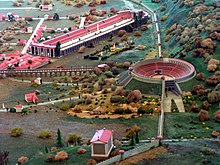Amphitheater (Trier)

The amphitheater in Trier ( Augusta Treverorum ) is an amphitheater from Roman times , which after its completion in the 2nd century offered space for 20,000 visitors.
Since 1986 the amphitheater has been part of the UNESCO World Heritage Roman Monuments, Cathedral and Church of Our Lady in Trier .
Architecture and location
There was a kind of cellar under the arena, which is still preserved today. There were lifts here to let the actors perform. It was therefore not possible to flood the arena with water. The amphitheater was part of the Roman city wall and is located below the Petrisberg . One of the reasons why the amphitheater on Petrisberg was built was that only half of the earth had to be filled up with earth for the grandstands due to the slopes of the Petrisberg. It is oriented to the north and has a north and a south exit. Animals or performers could be brought in quickly via a hidden elevator in the middle of the arena.
history
After the theater was built in the second half of the 2nd century AD, it quickly became part of the everyday life of many citizens of Trier. There, local dignitaries, imperial officials and, in late antiquity , some personally present emperors offered the citizens bread and games : animal hunt ( venationes ) and gladiator fights decided about life and death, executions took place and important announcements were made. The amphitheater also had another function - as an unusual feature: it served as the eastern city gate of Trier. After the end of the Western Roman Empire (5th century), like many other buildings in Trier, it was used as a quarry in the Middle Ages. It was used until the 5th century.
Until the 19th century, the population referred to the complex as a Kaskeller and also entered it on city maps. Only in the 19th century, when scientific research and restoration began, did this name disappear, which probably goes back to the use of the underground rooms of the amphitheater as a storage cellar.
Events
In summer guided tours through the amphitheater are offered, during which an actor slips into the role of the gladiator Valerius and tells of his career as a gladiator . In addition, until 2012, the amphitheater was the scene of the Bread & Games festival every August . Concerts, musicals and other events are rarely held there.
Bread & Games : Gladiator show in the amphitheater by day ...
literature
- Hans-Peter Kuhnen : Amphitheater Trier I: excavations and research 1816 - 1996. With contributions by Sibylle Bauer, Evamarie Bange-Goddard, Bruno Kremer, Hans-Peter Kuhnen, Stefan F. Pfahl and Marcus Thiel. (= Archeology from Rhineland-Palatinate. No. 2), Verlag Marie Leidorf , Rahden 2017, ISBN 978-3867576529 .
- Sabine Faust: Amphitheater. In: Rheinisches Landesmuseum Trier (ed.): Guide to archaeological monuments of the Trier region. Trier 2008, ISBN 978-3-923319-73-2 ( series of publications of the Rheinisches Landesmuseum Trier 35 ) p. 38f.
- Klaus-Peter Goethert: Amphitheater. In: Roman buildings in Trier. Guide booklet 20, Edition Burgen, Schlösser, Altert leads Rheinland-Pfalz, Schnell & Steiner, Regensburg 2003, ISBN 3-7954-1445-8 , pp. 59–75.
- Hans-Peter Kuhnen: The amphitheater. In: H.-P. Kuhnen (ed.): The Roman Trier. Theiss, Stuttgart 2001, ISBN 3-8062-1517-0 , pp. 92-101 (Guide to archaeological monuments in Germany 40).
- Joachim Hupe: The Roman city wall in the Trier amphitheater. A research problem in the light of old and new studies . in: Trier magazine, archeology and art of the Trier region and its neighboring areas, volume 79/80 (2016/17) ISBN 978-3-944371-08-5 .
Web links
- Official website of the amphitheater
- The Roman Trier
- Adventure tours with the gladiator Valerius
- Augusta Treverorum, Trier, Amphitheater (Gallia Belgica). In: Amphi-Theatrum .
Individual evidence
- ↑ VJJ v. Zuccalmaglio: The Moselle and its immediate surroundings from Coblenz to Trier, Koblenz 1833, p. 83.
Coordinates: 49 ° 44 ′ 53 " N , 6 ° 38 ′ 56" E







